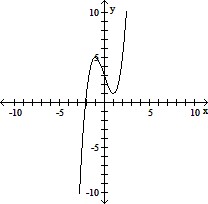Use a graphing calculator to solve the equation. Round your answer to two decimal places.ex - ln x = 4
A. {1.48}
B. {2.17}
C. {0.57}
D. {1.27}
Answer: A
You might also like to view...
Use the graph of the function f(x) to locate the local extrema and identify the intervals where the function is concave up and concave down.
A. Local minimum at x = 1; local maximum at x = -1; concave up on (0, ?); concave down on (-?, 0) B. Local minimum at x = 1; local maximum at x = -1; concave down on (-?, ?) C. Local minimum at x = 1; local maximum at x = -1; concave down on (0, ?); concave up on (-?, 0) D. Local minimum at x = 1; local maximum at x = -1; concave up on (-?, ?)
Solve the problem.Evaluate arccos  radians.
radians.
A. 
B. 
C. 
D. 
Evaluate the expression.(f ? g)(a) when f(x) = 6x + 7 and g(x) = 4x - 1.
A. 24a + 6 B. 24a + 13 C. 24a + 27 D. 24a + 1
Determine the appropriate rotation formulas to use so that the new equation contains no xy-term. x2 + 11xy + 12y2 + 4
x2 + 11xy + 12y2 + 4 y + 23 = 0
y + 23 = 0
A. x =  (2x' + y') and y =
(2x' + y') and y =  (x' - 2y')
(x' - 2y')
B. x =  (x' + 2y') and y =
(x' + 2y') and y =  (2x' - y')
(2x' - y')
C. x =  (2x' - y') and y =
(2x' - y') and y =  (x' + 2y')
(x' + 2y')
D. x =  (x' - 2y') and y =
(x' - 2y') and y =  (2x' + y')
(2x' + y')